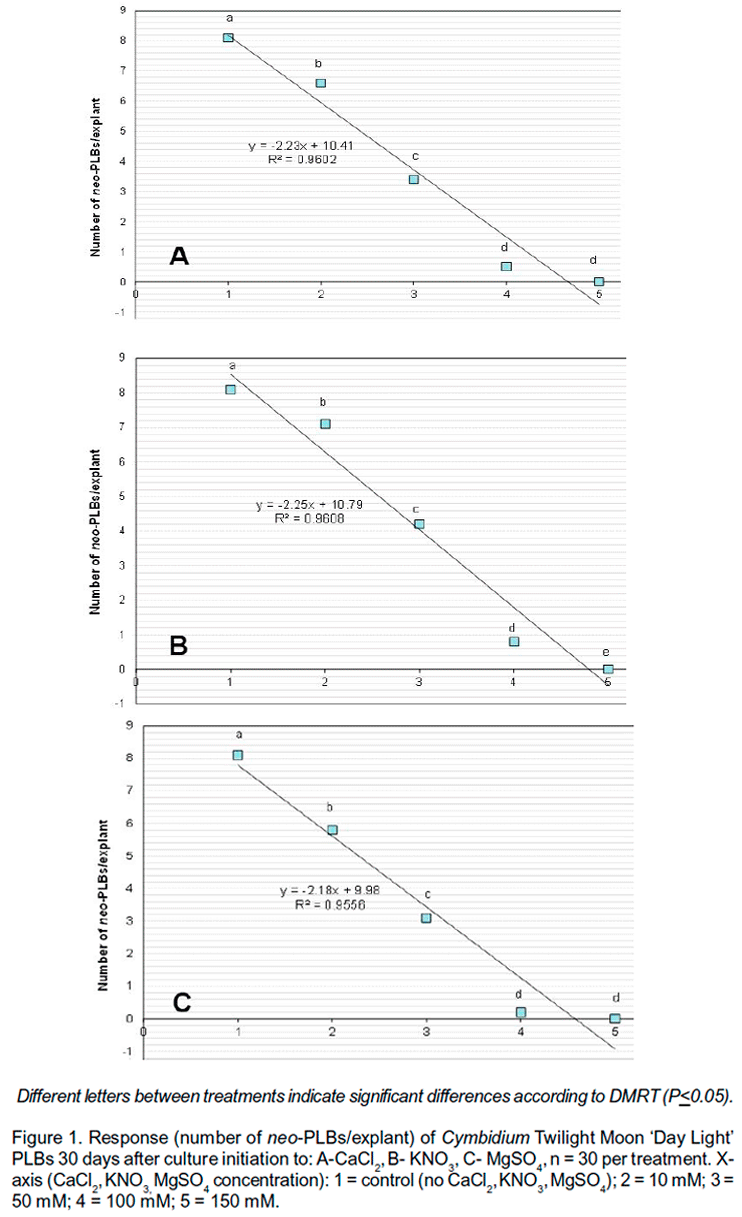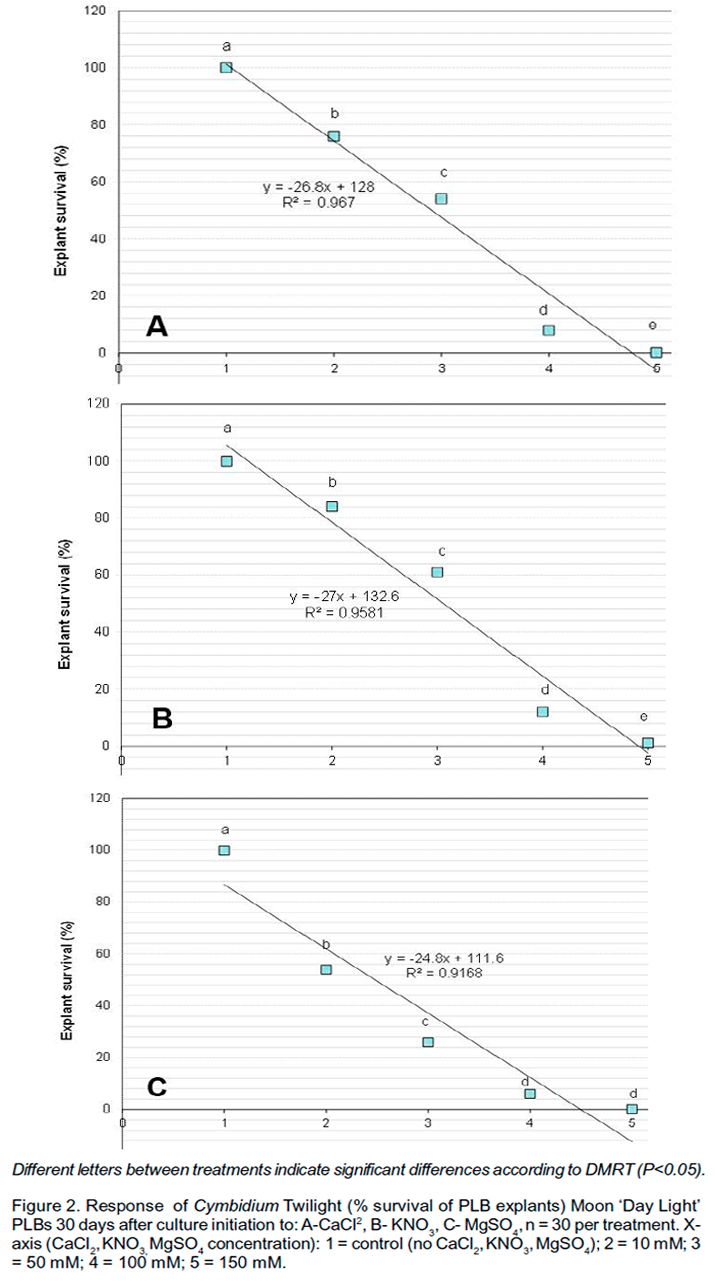ARTÍCULO ORIGINAL
Biotecnología
Vegetal Vol. 15, No. 3: 131 - 135, julio - septiembre, 2015
ISSN 2074-8647, RNPS: 2154 (Versión electrónica)
Instituto de Biotecnología de las Plantas. UCLV. MES.
Sensitivity of hybrid Cymbidium (Orchidaceae) to salt
stress (MgSO4, CaCl2 and KNO3)
Sensibilidad del Cymbidium híbrido (Orchidaceae) al estrés salino (MgSO4, CaCl2 and KNO3)
Jaime A. Teixeira da Silva 1,2
1Faculty
of Agriculture and Graduate School of Agriculture, Kagawa University, Miki-cho,
Kagawa, 761-0795, Japan (retired)
2Current address: Miki-cho post office, Ikenobe 3011-2, P. O. Box 7, Kagawa-ken, 761-0799, Japan. e-mail: jaimetex@yahoo.com
ABSTRACT
Hybrid Cymbidium Twilight Moon `Day Light' is highly sensitive to salt (NaCl). This is not surprising given the natural growth locations of tropical and subtropical orchids, which usually receive clean, and unsalted water. However, to expand the potential culture of orchids using diluted salt water, or brackish water, there is interest in testing the response of orchids to different salts that occur in sea water or brackish water. In this study, the response of protocorm-like bodies (PLBs) to three salts (MgSO4, CaCl2 and KNO3) was assessed. Unlike NaCl, neo-PLBs could form at higher concentrations of Mg2+, Ca2+ and K+ ions, with survival occurring at 50 mM. Although development was not optimum at this concentration of these salts, the ability to use diluted salt water or brackish water to induce orchid PLBs or to grow orchid plants would be an expansion of the possible culture conditions into developing countries or countries lined by the sea where access to clean or fresh water may be limited.
Keywords: CaCl2, KNO3, MgSO4, PLB, polyamines, Teixeira Cymbidium (TC) medium
Abbreviations: NAA, á-naphthaleneacetic acid; PLB, protocorm-like body; PGR, plant growth regulator
RESUMEN
Cymbidium híbrido Twilight Moon `Day Light' es altamente sensible a la sal (NaCl). Esto no es sorprendente teniendo en cuenta los lugares de crecimiento naturales de orquídeas tropicales y subtropicales, que por lo general reciben agua limpia y sin sal. Sin embargo, para ampliar el cultivo potencial de orquídeas con el uso de agua salada diluida o agua salobre, hay interés en probar su respuesta a diferentes sales que contiene el agua de mar o agua salobre. En este estudio, se evaluó la respuesta de cuerpos tipo protocormos (PLBs) a tres sales (MgSO4, CaCl2 y KNO3). A diferencia de NaCl, los neo-PLBs se podrían formar en presencia de altas concentraciones de iones Mg2+, Ca2+ y K+, con supervivencia a 50 mM. Aunque el crecimiento no fue óptimo a esta concentración de sales, la capacidad de utilizar el agua salada diluida o agua salobre para inducir PLBs o para cultivar plantas de orquídeas sería una ampliación de las posibles condiciones de cultivo en los países en desarrollo o países situados junto al mar donde el acceso a agua limpia o fresca puede ser limitada.
Palabras clave: CaCl2, KNO3, MgSO4, PLB, poliaminas, medio de Teixeira Cymbidium (TC)
INTRODUCTION
Water resources
need to be better managed as fresh water is becoming more limited, and more
wasted (Taft, 2015). The use of salt water or brackish water (the mixture of
fresh water and sea water) in agriculture, greenhouse production or in vitro
systems has always been a fascinating topic, but practical application has
always been limited by stress that is often
experienced by plants in response to salt. Filed trials have already taken place
(Sánchez et al., 2015) while only a single report has shown the
potential application of salty water for ornamental plant production (Cassaniti
et al., 2013).
Unlike halophytic species, which grow well under saline conditions (Muscolo, 2011), such as Conocarpus lancifolius (Al-Kandari et al., 2009), regular plants experience salt stress, affecting growth, physiology and yield (Ates and Tekeli, 2007) due to a disruption of metabolic processes caused by the accumulation of harmful oxygen radials (Cheeseman, 2007).
Teixeira da Silva (2015) showed that hybrid Cymbidium, an orchid, shows significant sensitivity to NaCl, the main constituent of sea water and that exists in ionic form, i.e., as Na+ and Cl (as much as 0.5-30‰; Lin and Brown, 1993). After chlorine and sodium, the next most abundant salts or ions are magnesium, sulphate, calcium and potassium, followed by other constituents, but several fold lower. This response to NaCl would not be unusual given that orchids, whether terrestrial or epiphytic, would usually receive relatively clean rainwater or fresh water without salts. This study thus aimed to expose the same Cymbidium hybrid to three other compounds carrying these main salts/ions of salt water (except for NaCl) to assess the developmental response, fulfilling thus a gap in the objectives of orchid biotechnology (Hossain et al., 2013).
This study assessed the response of hybrid Cymbidium protocorm-like bodies (PLBs) on Teixeira Cymbidium (TC) medium (Teixeira da Silva, 2012) to CaCl2, KNO3, and MgSO4.
MATERIALS AND METHODS
Plant material
PLBs of hybrid Cymbidium Twilight Moon `Day Light' (Bio-U, Tokushima, Japan). Stock PLBs of hybrid Cymbidium Twilight Moon `Day Light' were established and maintained as explained in detail in Teixeira da Silva (2012, 2014).
The application of the three compounds follow the protocol described for Teixeira da Silva (2015).
Neo-PLBs were kept in 100-mm diameter plastic Petri dishes (AsOne, Osaka, Japan) at 25°C, under a 16-h photoperiod with a light intensity of 45 µmol m-2 s-1 provided by plant growth fluorescent lamps (Homo Lux, Matsushita Electric Industrial Co., Japan).
To test the effect
of CaCl2 (anhydrous), KNO3 (anhydrous), and MgSO4
(heptahydrate, i.e.,
MgSO4·7H2O) on the development of neo-PLB
(i.e., new PLBs), PLBs were placed on TC medium containing 0, 10, 50,
100 and 150 mM of each compound. The number of neo-PLBs/explant and percentage
survival were determined for neo-PLBs after 30 days of culture.
Experiments were organized according to a randomized complete block design with three blocks of 10 replicates per treatment. All experiments were repeated in triplicate. Percentage values were arcsine transformed prior to analysis. Data was subjected to analysis of variance (ANOVA) with mean separation (P<0.05) by Duncan's Multiple Range test (DMRT) using SAS® vers. 6.12 (SAS Institute, Cary, NC, USA).
RESULTS AND DISCUSSION
Theoretically, one would not expect to find orchids to be tolerant to salt stress caused by growth after irrigation with salt water or brackish water. These ornamentals tend to be highly sensitive to extreme abiotic conditions, and exposure to NaCl in vitro at as little as 20 mM can significantly reduce the formation of neo-PLBs in hybrid Cymbidium (Teixeira da Silva, 2015). However, sea or brackish water contains other ions, primarily Mg2+, S2-, Ca2+ and K+, and thus there is interest in knowing the response to such ions. It should be noted that most artificial in vitro basal media for Cymbidium culture are made up of a wealth of macro- and micronutrients, and high or low ion media can significantly influence the formation of neo-PLBs (Teixeira da Silva et al., 2005; Teixeira da Silva, 2013).
The three ionic compound tested (CaCl2, KNO3, and MgSO4) showed a similar trend and response, with a significant negative effect on neo-PLB development and percentage survival of explants, necrosing at 100 and 150 mM in TC medium, and with an equally high correlation between compound ionic concentration and parameter (Fig. 1 y 2). Unlike NaCl, in which neo-PLB formation was negatively affected with as little as 20 mM NaCl (Teixeira da Silva, 2015), in this study, the negative impact of other salt ions was felt only at fold-higher concentrations. This indicates that hybrid Cymbidium is much more sensitive to NaCl (or Na+ and Cl- ions) that to other ions, or ionic compounds. Sea water or brackish water, if sufficiently diluted to 20-40 mM NaCl or maximum 50 mM of CaCl2, KNO3, and MgSO4, could in principle be used to induce Cymbidium PLBs in vitro or grow plants in the greenhouse where fresh water resources are not available, or are scant.
ACKNOWLEDGEMENT
The author thanks Prof. Michio Tanaka for providing research and laboratory facilities to conduct this research. The author declares no conflict of interest.
REFERENCES
Al-Kandari M, Redha A, Suleman P (2009) Polyamine accumulation and osmotic adjustment as adaptive responses to water and salinity stress in Conocarpus lancifolius. Functional Plant Science and Biotechnology 3(1): 42-48
Ates E, Tekeli AT (2007) Salinity tolerance of Persian clover (Trifulim resupinatum) lines at germination and seedling stage. World Journal of Agricultural Science 3: 71-79
Cassaniti C, Romano D, Hop MECM, Flowers TJ (2013) Growing floricultural crops with brackish water. Environmental and Experimental Botany 92: 165-175
Cheeseman JM (2007) Hydrogen peroxide and plant stress: a challenging relationship. Plant Stress 1: 4-15
Hossain MM, Kant R, Van PT, Winarto B, Zeng S-J, Teixeira da Silva JA (2013) The application of biotechnology to orchids. Critical Reviews in Plant Sciences 32(2): 69-139
Lin J, Brown CW (1993) Near-IR spectroscopic measurement of seawater salinity. Environmental Science and Technology 27: 1611-1615
Muscolo A, Sidari M, Panuccio MR, Santonoceto C, Orsini F, De Pascale S (2011) Plant responses in saline and arid environments: an overview. In: Muscolo A, Flowers TJ (Eds) Proceedings of the European COST action FA0901. The European Journal of Plant Science and Biotechnology 5 (Special Issue 2): 1-11
Sánchez AS, Nogueira IBR, Kalid RA (2015) Uses of the reject brine from inland desalination for fish farming, Spirulina cultivation, and irrigation of forage shrub and crops. Desalination 364: 96-107
Taft HL (2015) Water scarcity: global challenges for agriculture. In: Satinder Ahuja (Ed.) Food, Energy, and Water. The Chemistry Connection, pp. 395-429. Elsevier. Calabash
Teixeira da Silva JA (2012) New basal media for protocorm-like body and callus induction of hybrid Cymbidium. Journal of Fruit and Ornamental Plant Research 20(2): 127-133
Teixeira da Silva JA (2013) Ammonium to nitrate ratio affects PLB formation in vitro of hybrid Cymbidium. Journal of Ornamental and Horticultural Plants 3(3): 155-160
Teixeira da Silva JA (2014) Filter paper inhibits in vitro protocorm-like body formation in hybrid Cymbidium and reduces synseed germination, but buffers the negative impact of antibiotics. Biological Letters 51(1): 47-54
Teixeira da Silva JA (2015) Sensitivity of hybrid Cymbidium to salt stress and induction of mild NaCl stress tolerance. Environmental and Experimental Biology 13(2): 89-92
Teixeira da Silva JA, Yam T, Fukai S, Nayak N, Tanaka M (2005) Establishment of optimum nutrient media for in vitro propagation of Cymbidium Sw. (Orchidaceae) using protocorm-like body segments. Propagation of Ornamental Plants 5(3): 129-136
Recibido: 20-05-2015
Aceptado:
08-09-2015
Copyright (c) 2016 Biotecnología Vegetal
![]()
Biotecnología Vegetal eISSN 2074-8647, RNPS: 2154. ISSN 1609-1841, RNPS: 0397 Editada por: Instituto de Biotecnología de las Plantas. Universidad Central Marta Abreu de Las Villas. Carretera a Camajuaní km 5.5, Santa Clara, Villa Clara, Cuba CP 54 830 Tel: 53 42200124, e-mail: info@ibp.co.cu

Biotecnología Vegetal está bajo una Licencia Creative Commons Atribución-NoComercial 4.0 Internacional.


